The following is an article that originally appeared in Modern Photography magazine, July 1980.
Is Your Exposure Meter On Target?
Are perturbing exposure perturbations crippling your precious pictures? Here's how to find the culprit.
by Peter Moore
Is your trusty Gossen, Weston or Minolta meter, or your camera itself, really trusty? Is it you, your freaky subject matter, or has your hardware blown its cool? Exposure meters and in-camera metering systems are remarkably accurate instruments—but they are not indestructible or immune to aging.
Most exposure measuring systems are powered by batteries these days. And this introduces battery problems (test 'em), contact corrosion (clean 'em), and switch problems (exercise it to keep contacts clean). Steady use. good housekeeping, and a spare battery are a minor price to pay for the great sensitivity of modern meters. Exercise care—after all, you can lose use of your camera itself, as well as the metering system if you don't keep your batteries fresh and carry a spare. Until, of course, some enterprising film manufacturer puts out roll film with a small battery as the center core.
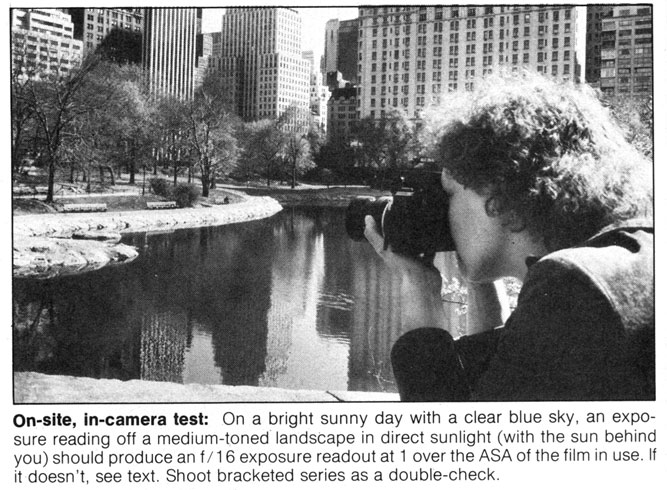 What else can go wrong with your metering hardware? If you drop it, 'nuf said, you must regard it with suspicion as well as dismay. Only the solid-state digital readout meters are likely to survive this kind of damage. If you drop your camera, or bang it carelessly against a door-jamb, your metering system may be just part of the problem. Shocks can knock needles off their pivots, or bend them so that they rub against their housings, cells can age. Selenium cells in older photovoltaic meters can suffer from internal contact corrosion or deteriorate due to atmospheric influences or humidity. Potentiometers used for calibration, switch contacts, and PC board terminals can suffer likewise. Sometimes the darned things will break down altogether, sometimes they'll go off uniformly down the line, and sometimes—worst and hardest of all to check—are what technical types refer to as non-linear changes. Your metering may be right-on at high light levels and way off at low levels, or vice-versa.
What else can go wrong with your metering hardware? If you drop it, 'nuf said, you must regard it with suspicion as well as dismay. Only the solid-state digital readout meters are likely to survive this kind of damage. If you drop your camera, or bang it carelessly against a door-jamb, your metering system may be just part of the problem. Shocks can knock needles off their pivots, or bend them so that they rub against their housings, cells can age. Selenium cells in older photovoltaic meters can suffer from internal contact corrosion or deteriorate due to atmospheric influences or humidity. Potentiometers used for calibration, switch contacts, and PC board terminals can suffer likewise. Sometimes the darned things will break down altogether, sometimes they'll go off uniformly down the line, and sometimes—worst and hardest of all to check—are what technical types refer to as non-linear changes. Your metering may be right-on at high light levels and way off at low levels, or vice-versa.
What under the sun can you do to check for these Eisendrathian meter gremlins? Use old Sol, to begin with. The sun is an almost perfect photometric test setup. During summer and winter in the temperate zones, in clear weather with a clear blue sky, the sun puts out a steady 1000 foot-lamberts plus or minus about 1/3 stop at ground level. Even with the mathematical leverage of the inverse square law (illumination varies inversely as the square of your distance from the source—and the sun is a near-perfect point light source), the 1.6-million-mile variation in the Earth's mean 96-million-mile solar distance doesn't amount to a hill of photons ƒ/stop-wise.
In case you're wondering why we have winter, on the one hand, or need light meters at all, on t'other, suspect the atmosphere as the culprit. In winter, the earth's axis presents itself at a different angle to the sun's rays and different parts of our globe get the full heat treatment. Camera and meter manufacturers thrive on sales of light-measuring and exposure-control hardware because we rarely photograph 18 percent reflective landscapes under clear skies with the sun behind our shoulders.
If 1000 foot-lamberts doesn't turn you on, direct your gaze to the sunny ƒ/16 rule—the golden rule of photography. Given the same 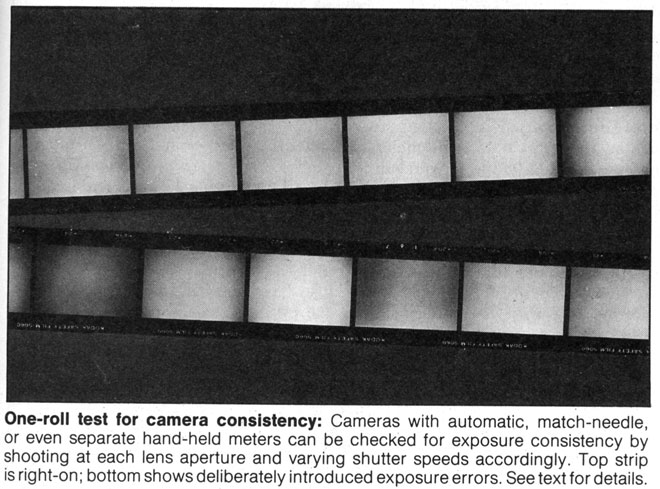 halcyon shooting conditions, 1000 foot-lamberts will produce correct exposure with an ƒ/16 aperture at a shutter speed of 1 over the ASA speed of the film in use.
halcyon shooting conditions, 1000 foot-lamberts will produce correct exposure with an ƒ/16 aperture at a shutter speed of 1 over the ASA speed of the film in use.
If, on a clear day, your camera- or meter-indicated exposure is something grossly different from 1/64 (or 1/60) at ƒ/16 for an ASA 64 film, 1/400 sec. (use 1/500) at ƒ/16, for Tri-X, etc., you have grounds for suspicion. Chances are your subject is not medium in tone, you've misjudged your atmospheric conditions, or your equipment is acting up. Our industrial excesses are tending to pump an atmospheric filter factor into the area between the sun and our subjects. In New York City, for example, I am rarely able to get ƒ/16—more like ƒ/11 ½, so I adopt that as my standard.
Nevertheless, I feel confident enough with this system by now to use it to double-check my outdoor camera settings and exposures to within ½ to 1 stop. If the meter fails. I can still expose film confidently, and, as an added bonus, it makes me check my camera or meter film-speed settings if I forget to change them. Basically, the idea is to build up a clear idea of correct outdoor exposures and a suspicious attitude about variations from them.
The Old Sol ƒ/16 system is as dependable as the geometry of the solar system and your ability to judge blue sky. It's about the only test that will give you a quantitative indication that your metering is awry. Indeed, the system's good enough to use for meter calibration. Proper use of the ƒ/16 rule, modifying the aperture for different weather conditions and for back, front or side lighting will produce good exposures under most outdoor conditions. Unlike your hand: held or in-camera reflected-light meter, the system is independent of subject tone and will give you correct exposure for light, medium or dark subjects directly, like an incident meter. Look at exposure tables, computers and film instruction sheets with new respect.
Stepping indoors, we can find a number of easy, and nearly-easy, methods for comparing reflected light meters of various types and in-camera meters to check for relative accuracy and consistency of calibration. We'll limit our discussions here to reflected type meters and camera meters of all types. Incident meters can be checked easily against the sun—and that is the best and easiest way to do so— at ƒ/16 and 1/ASA.
A comparative test
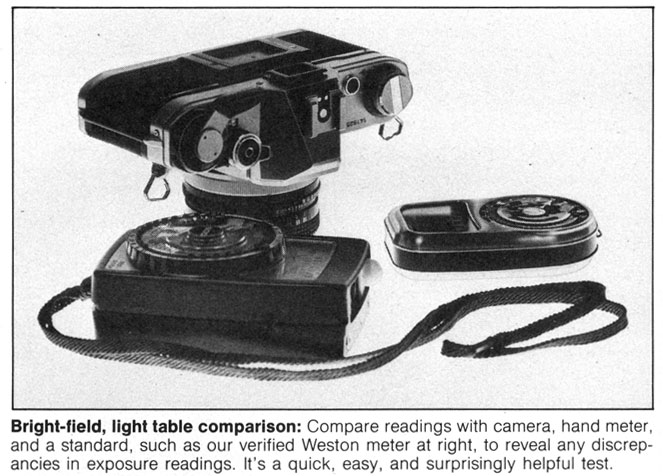 To judge meter accuracy at a given light level, all you need is your camera with built-in meter and one other meter, and an illuminated light box, such as a transparency viewer, against which you can place your camera lens or meter receptor. Compare readings made at the same ASA and shutter speed settings in terms ofƒ/stop deviations and errors will be clearly shown. I tested several cameras, some hand meters up to 10 years old, and a couple of spot meters, and found deviations up to one full stop; but most were under plus or minus half a stop. Finding a discrepancy this small between old selenium, new CdS and silicon cell systems was a revelation, both of the effectiveness of our simple test and the accuracy of meter calibrations over a period of up to 10 years.
To judge meter accuracy at a given light level, all you need is your camera with built-in meter and one other meter, and an illuminated light box, such as a transparency viewer, against which you can place your camera lens or meter receptor. Compare readings made at the same ASA and shutter speed settings in terms ofƒ/stop deviations and errors will be clearly shown. I tested several cameras, some hand meters up to 10 years old, and a couple of spot meters, and found deviations up to one full stop; but most were under plus or minus half a stop. Finding a discrepancy this small between old selenium, new CdS and silicon cell systems was a revelation, both of the effectiveness of our simple test and the accuracy of meter calibrations over a period of up to 10 years.
But what can you do if you have a half-stop difference between your camera system and your hand meter? The problem is twofold: The first challenge is deciding which is right; the second is to make the other meter conform to it.
The proof of the exposure system is in the exposures. The system that yields the best exposures consistently is "accurate." You can photograph your average landscape under ƒ/16 conditions, bracket plus or minus a stop in half-stops, pop the processed slides into your projector and pick the exposure that projects best, modifying your film speed accordingly. If one stop of overexposure is necessary, use half the recommended ASA, for ½ stop split the difference. If a stop underexposure is needed, double your ASA; for ½ stop, again split the difference.
I keep a carefully calibrated and protected Weston Master III selenium cell meter which I know to be within 1/6 stop of accuracy as a standard against which to compare my other meters on the light table. I then conform my other meters to the standard by marking them "+ ½ stop." "-1 stop," etc., or I modify my film speeds, marking them "½ ASA" or "1.5 x ASA."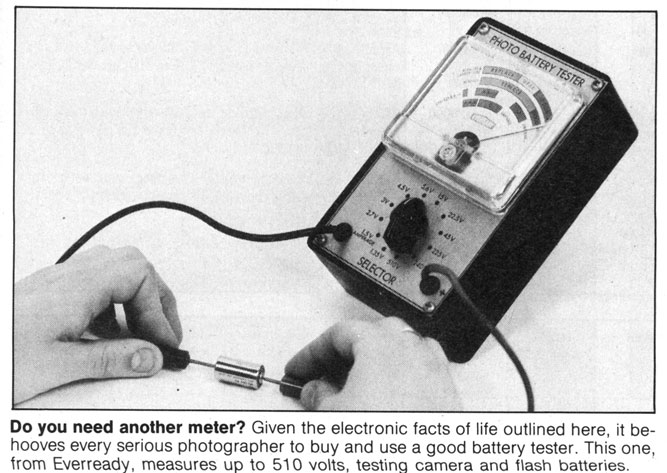
How do I know my standard meter's right? I had it hand-calibrated by Martin Satloffat Empire Exposure Meter Service. 45 West 45 Street, NYC, NY 10036. Better camera repair outfits and exposure meter specialists such as Marty make a business of fine-tuning meters for professional still and motion-picture photographers and have the finely-honed test equipment, standard light sources, and the expertise necessary to do the job right. Plus or minus fractional stop accuracy is routine for them. Send your cameras to camera repairmen and your meters to meter men (or maids).
A full-range test
Our simple light box and comparison procedure has its limitations. Using a color transparency illuminator, we are working with fluorescent light of approximately daylight color temperature, and remarkable constancy. But light output may change with voltage, use, temperature, or bulb age. It's OK for real-time comparisons against a standard meter, but is not a constant "standard" light source by any means. Since our source is bright and non-adjustable, our comparisons are only valid at one point on the brightness scale. Our box is very bright, only one ƒ/stop darker than a sunny-day exposure. We cannot test easily for low-light-level performance with it. And sometimes, as we have mentioned, low-and high-light-level performance may be non-uniform.
A primitive but effective photometric bench can be built simply and will provide more constant and yet controllable light output. We used a Vivek voltage regulator to put 100 volts into a 110-v Tensor desk lamp, an empty, telescoped 8x 10 double-weight paper box with a 3-in. aperture cut through top and bottom with two layers of tracing paper between the cover and the box bottom for diffusion. A Kodak gelatine filter frame (Cat. No. 148 6620) was taped to the box top of the side away from the lamp. We varied the lamp-to-diffuser distance until a full-scale meter reading (ƒ/16 at 1/ASA again) was obtained and then taped the lamp down. Inserting in turn, and in combination, 3-in. Kodak gelatine .3, .6 and .9 ND (neutral density) filters, we can check calibration over a seven-stop range. Once the lamp is located and fixed for full output, the voltage regulator should maintain relatively constant output until the lamp begins to blacken. A quartz-iodine lamp, power supply and regulator would be even more constant.
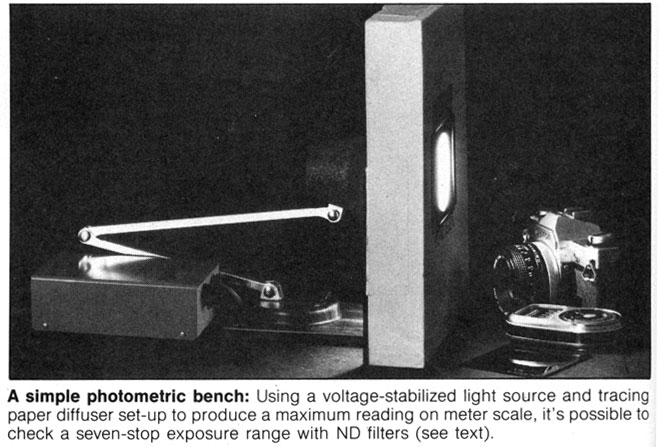 It's possible that a quartz-iodine bulb equipped dichroic color head, power supply, regulator, and lens (throwing a beam against a diffuser) could be set up and calibrated as a variable-color, variable-output light source using the diaphragm as an attenuator, but we've not experimented with this.
It's possible that a quartz-iodine bulb equipped dichroic color head, power supply, regulator, and lens (throwing a beam against a diffuser) could be set up and calibrated as a variable-color, variable-output light source using the diaphragm as an attenuator, but we've not experimented with this.
| Output | ND filtration |
|---|---|
| Full | none |
| -1 stop | ND .3 |
| -2 stops | ND .6 |
| -3 stops | ND .9 |
| -4 stops | .9 + .3 |
| -5 stops | .9 + .6 |
| -6 stops | .9 + .6 + .3 |
Although calibrations could be checked out over at least a seven-stop range with this rig, I'm tempted to doubt, in all honesty, the utility of going this far with your testing. If you can't do anything to cure a situation, it is of little help to be able to define the problem in great detail. Our procedure here is rough and ready in photometric terms, and not capable of the full control and refinement necessary to do justice to the problem. Most repair shops will have much more sophisticated test gear—and the know-how to go into your camera or meter to make the necessary adjustments.
The next easy test is for exposure consistency. Using either a light table and slow film or an evenly-lit white wall as a subject, set your camera or meter for the ASA film speed and your lens' widest aperture. Meter the wall, set the lens wide open, and expose at the indicated shutter speed. Continue stopping down and changing shutter speeds as indicated until you run out of ƒ/stops. Process the film for normal contrast and you'll end up, hopefully, with an evenly-exposed set of matching gray negatives or slides. This indicates that the meter reading, camera lens calibrations and diaphragm action, and camera shutter speeds are accurate within close tolerances. If you read the negatives with a densitometer. variations of plus or minus .1 D would indicate exposure errors of plus or minus 1/3 stop. Our top strip, exposed on "automatic" with an Olympus OM-2. has good exposure consistency—showing a well adjusted meter and good mechanical consistency. On our second strip, we deliberately varied the exposure in 1/3, 2/3 and full-stop intervals so you could see what major system errors would look like.
And finally, some mechanical points to look for. drawn partially from "Check Before You Buy" (Modern Photography, Dec. 1979, p 8).
We put these last, because errors of this type are relatively obvious.
Problems and cures
No reading: Check or replace battery. Replace. Clean contacts. Exercise on/off switch.
Erratic readings: Cover and uncover cell or lens and watch for stickiness in needle travel or spotty LED indication. Read evenly-lit surface with meter or camera horizontal, then vertical-one or more stops discrepancy indicates bad balance and need for repair. Check contacts for corrosion.
Erratic exposures: Operate stop-down control or lever and watch action from front to see if diaphragm's sticky—have cleaned if necessary. Repair's the only cure for sticky needle or faulty shutter.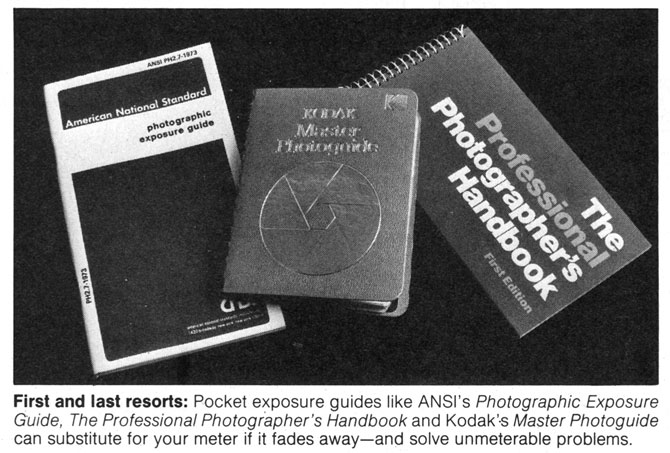
References and guides
Dunn and Wakefield, Exposure Manual, Third Edition, Fountain Press. Best readable reference book.
ANSI Photographic Exposure Guide PH2.7-1973, from American National Standards Institute, 1430 Broadway, New York, NY 10018; $5 plus $2 handling. Sound and systematic approach to metering without a meter by daylight, moonlight, subjects such as auroras, eclipses, rainbows. Mathematically demanding for daylight use, simple, clear-cut recommendations for exotica.
The Professional Photographer's Handbook, First Edition, Larry Logan, ed., from Logan Design Group, 6101 Mel-rose Ave., Los Angeles, CA 90038; $14.95. Pocket-size spiral notebook with very comprehensive tables of data most needed in the field. Very useful.
Kodak Master Photoguide, AR-21, from dealers or Kodak, Dept. 454, Rochester, NY 14650; $5.75. That indispensable rugged little book with all those cardboard calculators. Good to begin with, steadily improved over the years. Easy to read and use, hard to get along without. Covers only Kodak materials.
—The End
